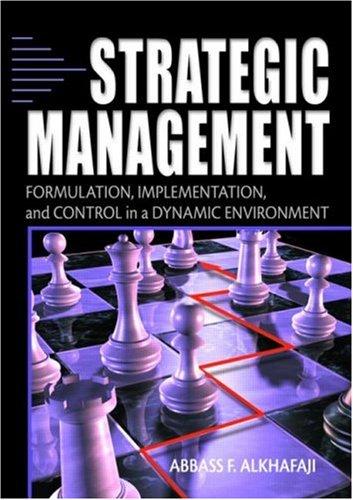Question
16) According to Bandura's self-efficacy theory, the four sources of efficacy beliefs are: a) Enactive mastery, vicarious modelling, verbal persuasion, arousal b) Valence, instrumentality, expectancy
16) According to Bandura's self-efficacy theory, the four sources of efficacy beliefs are:
a) Enactive mastery, vicarious modelling, verbal persuasion, arousal
b) Valence, instrumentality, expectancy and motivation
c) Self-confidence, enactive mastery, vicarious modelling, verbal persuasion
d) Personal ability, previous experience, mental ability and self-confidence
17) A British food company reduced absenteeism by giving employees with perfect attendance each
month two chances (through a lottery) to win $500. This is an example of:
a) Tacit knowledge
b) Behaviour modification
c) Social learning
d) Social loafing
18) When employees receive a reward that they find very undesirable, expectancy theory states that
they have:
a) A low expectancy
b) An inappropriate comparison other
c) A negative valence
d) A low instrumentality
19) Normal Technologies Corp. (NTC) offers superb fitness facilities, flexible work hours, a
gourmet restaurant with company-subsidised meals, and a workplace with security systems for
high physical safety. According to Herzberg's motivator-hygiene theory, these conditions will:
a) Motivate all of NTC's employees to perform their jobs better.
b) Motivate employees whose lower-level needs have not yet been satisfied.
c) Increase job satisfaction among employees who value those conditions.
d) Reduce job dissatisfaction among NTC's employees but will not motivate them in
performing their jobs.
20) Stress is best described as:
a) The physiological disorders we experience from adverse environmental conditions.
b) An adaptive response to a situation that is perceived as challenging or threatening to the
person's wellbeing.
c) A series of events that cause emotional exhaustion and depersonalisation towards
customers.
d) Environmental conditions that place a physical or emotional demand on the person.
21) Hindrance stressors can be defined as _________.
a) Demands or circumstances that, although potentially stressful, have associated potential
gains for individuals
b) Demands or circumstances that tend to interfere with an individual's work achievement and
have no potential gains for the individual
c) The lack of freedom to control and organise one's work
d) None of the above
22) Which of the following is an advantage of job specialisation?
a) The work is less repetitive
b) Jobs can be mastered quickly
c) Employees are more involved with their jobs
d) Task specialisation has no clear advantages to the organisation
23) Group polarisation occurs when:
a) A decision-making team is divided with opposing views regarding the best solution to a
problem.
b) A team tends to make more extreme decisions than individuals making the decision alone.
c) A highly cohesive team tries to maintain harmony within the group.
d) A team is clearly divided into two ethnic or gender groups.
24) Teams engage in devil's advocacy when they want to:
a) Increase the chances of group polarisation
b) Apply brainstorming
c) Decrease the chances of groupthink
d) Apply the nominal group technique
25) In organisational behaviour, what is servant leadership?
a) The view that leaders serve followers, rather than vice versa
b) The view that teams work best when there is a strong leader and subservient followers
c) Training for employees in how to respond to requests from management
d) Training for leaders in how to be authentic
26) Which of the following is NOT a distinct source of power?
a) Centrality power
b) Legitimate power
c) Coercive power
d) Expert power
27) Complex and ambiguous rules in resource allocation decisions cause employees affected by
those decisions:
a) To disown their Machiavellian values
b) To engage in more organisational politics
c) To disband their politically motivated networks
d) None of the above
28) The two main forms of conflict within organizations are:
a) Manifest and hidden
b) Task-related and relationship
c) Pooled and sequential
d) Collaborating and competing
Step by Step Solution
There are 3 Steps involved in it
Step: 1

Get Instant Access to Expert-Tailored Solutions
See step-by-step solutions with expert insights and AI powered tools for academic success
Step: 2

Step: 3

Ace Your Homework with AI
Get the answers you need in no time with our AI-driven, step-by-step assistance
Get Started


